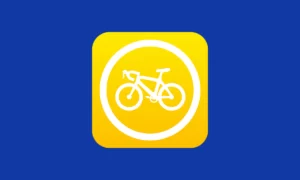Navigating the world of cycling apps can be as challenging as tackling a steep, winding trail, but the Komoot App makes the journey simpler and more enjoyable for cyclists of all levels.
Designed with both the urban commuter and the off-road adventurer in mind, Komoot offers a suite of tools that not only guide you from point A to B but also enhance your riding experience by adapting to your personal needs and preferences. Its user-friendly interface and detailed, customizable routes promise to transform how you explore on two wheels.
As you dive deeper into the Komoot App, you’ll discover a community-driven platform where cyclists share their favorite routes and tips, creating a rich repository of information and experiences. Whether you’re looking for the fastest path through city streets or seeking rugged mountain trails, Komoot delivers with precision and reliability.
Continue reading to uncover how this app can optimize your cycling routes, improve your training, and connect you with a global network of like-minded enthusiasts, ensuring every ride is an adventure worth taking.

Image Source: Komoot App
Introduction to Komoot: History and Benefits
Komoot is a route planning and navigation platform, founded in 2010, that caters specifically to outdoor enthusiasts. It offers detailed, voice-guided navigation for cycling, hiking, and mountain biking, using a mix of open-source and proprietary data to generate optimized routes.
Komoot’s unique selling point is its ability to provide tailored routes that suit an individual’s fitness level and adventure preferences. The platform also allows users to save and share their favorite routes with a community, enhancing the experience through user contributions and feedback.
Steps to Explore the History and Benefits of Komoot:
- Explore the Origin: Learn about Komoot’s inception in 2010 and its evolution into a leading outdoor navigation app.
- Discover the Features: Familiarize yourself with Komoot’s core features such as detailed mapping, route planning, and community engagement.
- Utilize the Platform: Start using Komoot to plan your next outdoor adventure and experience its benefits firsthand.
- Join the Community: Engage with other users by sharing routes and tips, and gain insights from their experiences.
- Review User Feedback: Check reviews and testimonials to understand how Komoot has benefited other outdoor enthusiasts.
The Important Role of Komoot in Cycling Training
Komoot is an invaluable tool for cyclists, providing detailed route planning that helps in structuring training sessions effectively. The platform offers routes that are tailored to the cyclist’s skill level and goals, with comprehensive data on terrain, elevation, and road types.
This specificity aids cyclists in focusing their training on particular areas, whether it’s endurance, speed, or technical skills. Furthermore, Komoot’s tracking features allow cyclists to monitor their progress and adjust their training plans accordingly.
Tips for Leveraging Komoot in Cycling Training:
- Customize Your Training Routes: Use Komoot to build routes that match your training goals, focusing on specific challenges like climbs or technical descents.
- Analyze Route Data: Before you head out, study the route’s profile for elevation and surface type to tailor your training to your fitness goals.
- Track and Adjust: Utilize Komoot’s tracking features to analyze your performance and make necessary adjustments to your training plan.
- Simulate Race Conditions: Prepare for races by using Komoot to find routes that simulate similar conditions to those expected on race day.
- Stay Motivated: Join challenges within the Komoot community to stay motivated and push your limits.
- Share and Learn: Share your routes and training insights with the community and learn from the experiences of other cyclists.
How to Download and Start Using Komoot for Cyclists
Komoot is a versatile navigation tool designed to enhance the cycling experience, whether you’re a commuter or a mountain biker. It offers detailed route information, navigation, and tracking features.
Cyclists can benefit from Komoot’s comprehensive database of paths, trails, and road types, tailored to suit various cycling preferences and levels of expertise.
Steps to Download and Start Using Komoot for Cyclists:
- Download the App: Visit your mobile app store, search for Komoot, and download it to your smartphone. (Android or iOS)
- Create an Account: Open the app and sign up for an account. You can use an email address or connect through a social media account.
- Set Up Your Profile: Enter details about your cycling preferences, fitness level, and what type of cycling you’re interested in (e.g., road, mountain biking).
- Plan Your First Route: Use the route planner to input your starting point and desired destination. Adjust the route based on your preference for distance and difficulty.
- Start Navigation: Use the turn-by-turn navigation on your first ride to get accustomed to Komoot’s interface and features.
- Explore and Connect: Look for recommended routes from other users, join challenges, and connect with the community to get the most out of your Komoot experience.
Using Komoot for Urban Cycling vs. Mountain Biking
Komoot offers tailored features that suit both urban cycling and mountain biking, making it a flexible choice for different types of cyclists. Each cycling discipline benefits from specific aspects of the app, from navigating city streets to exploring rugged trails.
Tips for Using Komoot for Urban Cycling vs. Mountain Biking:
- Urban Cycling
- Route Customization: Choose safer, bike-friendly roads and avoid high-traffic areas.
- Offline Maps: Download city maps for offline use to ensure you can navigate without a data connection.
- Live Tracking: Share your location with friends or family for safety during your rides.
- Mountain Biking
- Terrain Information: Make use of Komoot’s detailed topographical maps and trail types to plan your route according to your skill level.
- Weather Features: Check the weather integration feature to avoid sudden changes in weather that are common in mountainous areas.
- Difficulty Level: Adjust the route’s difficulty based on your experience and fitness level to ensure a challenging yet manageable ride.
By using Komoot strategically, cyclists can maximize their efficiency and enjoyment whether they’re navigating the urban jungle or conquering mountainous terrains.
Tips to Maximize GPS Accuracy in Komoot
Maximizing GPS accuracy in Komoot is crucial for ensuring reliable navigation and tracking during your outdoor activities. To begin, ensure that your device’s GPS settings are optimized. This often involves enabling high accuracy mode, which allows your device to use GPS, Wi-Fi, and mobile networks to determine your location.
Additionally, it’s important to keep your device’s software and the Komoot app updated, as updates often include improvements to GPS functionality. When starting your activity, give your device a few minutes to acquire a stable GPS signal before starting to move. This can be particularly important in areas where GPS signals are weak, such as densely wooded or urban areas with tall buildings.
When using Komoot, the placement of your device can also affect GPS accuracy. For cyclists, mounting the phone on the handlebars facing the sky can help improve signal reception compared to having the phone in a pocket or backpack.
If accuracy issues persist, consider using an external Bluetooth GPS receiver, which can be more precise than your smartphone’s built-in GPS. These devices are typically more sensitive and maintain better lock-on to GPS satellites, thus providing more accurate tracking data to apps like Komoot.

Image Source: Image Generated With DALL-E on ChatGPT
Tips for Using Offline Maps in Komoot
Using offline maps in Komoot can significantly enhance your experience by providing navigation certainty in areas with poor or no internet connection. To utilize offline maps effectively, first ensure that you download the necessary regional maps before your trip.
Komoot allows you to select specific regions for download, ensuring you have detailed, navigable maps even without cellular data. This feature is especially useful for long-distance trips in remote areas where connectivity is limited.
Downloading maps in advance also helps conserve battery life, as your device won’t need to use mobile data to load maps while on the go. When planning your routes with offline maps, take advantage of Komoot’s route planning features which allow you to see elevation profiles, estimated difficulty, and surface types.
This pre-planning can help you avoid unexpected challenges on the trail or road. Keep your device’s battery in mind; even when using offline maps, GPS tracking can drain your battery. It’s wise to carry a portable charger or consider battery-saving settings on your device to extend its life throughout your adventure.
Regularly update your saved maps when connected to Wi-Fi to ensure that any changes or updates to the trails or roads are reflected in your offline maps, keeping your navigation as accurate as possible.
Frequently Asked Questions About the Komoot App for Cyclists
1. What makes Komoot different from other cycling apps? Komoot specializes in route planning and navigation for outdoor activities, offering tailored routes that are optimized for your specific cycling preferences and fitness levels. It also provides detailed topographical maps and trail conditions, which are particularly beneficial for off-road cycling.
2. Is Komoot free to use, or are there charges? Komoot offers both free and paid features. The free version includes basic route planning and navigation, while the premium version, Komoot Premium, provides additional features such as multi-day route planning, weather forecasts, and personal collections.
3. Can Komoot be used for both road cycling and mountain biking? Yes, Komoot is designed to cater to all types of cyclists. It allows you to customize routes based on the type of cycling, whether you’re on the road or exploring mountain trails.
4. How does offline navigation work in Komoot? Offline navigation in Komoot requires you to download the maps of your intended area in advance. Once downloaded, you can access these maps and navigate without an internet connection, ensuring reliable guidance no matter how remote your location.
5. How accurate is Komoot’s GPS tracking? Komoot’s GPS tracking accuracy largely depends on your device’s GPS capabilities. To improve accuracy, ensure your device has a clear view of the sky and consider using external GPS devices if necessary.
6. Can I share my routes with others on Komoot? Yes, Komoot has a strong community feature that allows you to share routes with others. You can also follow other users, exchange tips, and explore routes created by the community.
Komoot stands out as a versatile application tailored specifically for cyclists, blending detailed navigational tools with user-friendly features. Its ability to cater to different cycling disciplines makes it a favored choice among both casual riders and serious mountain bikers.
The app’s emphasis on community and shared experiences enhances its appeal, encouraging users to explore new terrains confidently and with the right information at their fingertips. Furthermore, Komoot’s adaptability in offering offline navigation options ensures that cyclists have reliable access to route guidance even in the most remote areas.
This functionality, combined with the ability to track and analyze one’s own cycling data, makes Komoot not just a navigation tool, but a comprehensive companion for anyone passionate about cycling. Whether you are planning a short local ride or an extensive mountain biking adventure, Komoot provides the necessary tools to make your journey safe, enjoyable, and memorable.
Did you like this article? Discover other articles related to applications for cyclists here. Or check out more related articles below.






